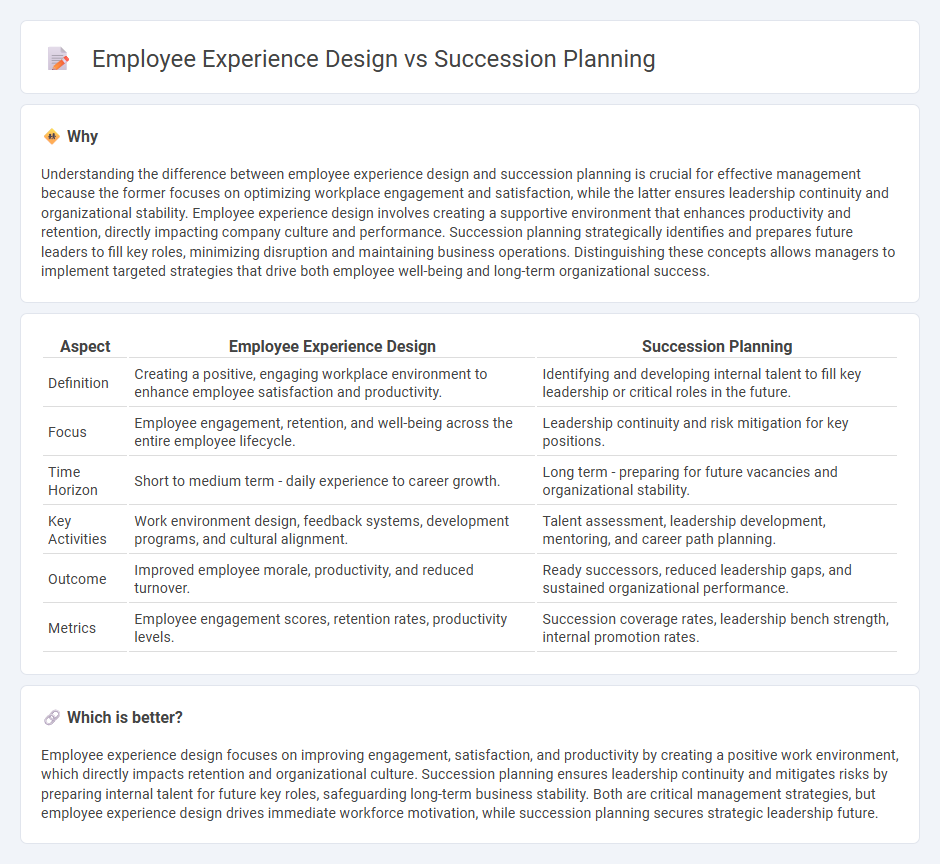
Employee experience design focuses on creating a positive and engaging work environment to boost productivity and retention. Succession planning strategically identifies and develops future leaders to ensure organizational continuity and growth. Explore how integrating these approaches can transform your management strategy.
Why it is important
Understanding the difference between employee experience design and succession planning is crucial for effective management because the former focuses on optimizing workplace engagement and satisfaction, while the latter ensures leadership continuity and organizational stability. Employee experience design involves creating a supportive environment that enhances productivity and retention, directly impacting company culture and performance. Succession planning strategically identifies and prepares future leaders to fill key roles, minimizing disruption and maintaining business operations. Distinguishing these concepts allows managers to implement targeted strategies that drive both employee well-being and long-term organizational success.
Comparison Table
| Aspect | Employee Experience Design | Succession Planning |
|---|---|---|
| Definition | Creating a positive, engaging workplace environment to enhance employee satisfaction and productivity. | Identifying and developing internal talent to fill key leadership or critical roles in the future. |
| Focus | Employee engagement, retention, and well-being across the entire employee lifecycle. | Leadership continuity and risk mitigation for key positions. |
| Time Horizon | Short to medium term - daily experience to career growth. | Long term - preparing for future vacancies and organizational stability. |
| Key Activities | Work environment design, feedback systems, development programs, and cultural alignment. | Talent assessment, leadership development, mentoring, and career path planning. |
| Outcome | Improved employee morale, productivity, and reduced turnover. | Ready successors, reduced leadership gaps, and sustained organizational performance. |
| Metrics | Employee engagement scores, retention rates, productivity levels. | Succession coverage rates, leadership bench strength, internal promotion rates. |
Which is better?
Employee experience design focuses on improving engagement, satisfaction, and productivity by creating a positive work environment, which directly impacts retention and organizational culture. Succession planning ensures leadership continuity and mitigates risks by preparing internal talent for future key roles, safeguarding long-term business stability. Both are critical management strategies, but employee experience design drives immediate workforce motivation, while succession planning secures strategic leadership future.
Connection
Employee experience design enhances engagement and skill development by creating tailored career paths and supportive work environments, directly feeding into effective succession planning frameworks. Succession planning relies on insights from employee experience data to identify high-potential talent and nurture leadership capabilities aligned with organizational goals. Integrating these strategies ensures a continuous pipeline of prepared leaders while fostering a culture of growth and retention.
Key Terms
Succession Planning:
Succession planning ensures organizational stability by identifying and developing internal talent to fill key leadership roles, reducing risks associated with unexpected vacancies. This strategic approach enhances workforce readiness, aligns talent development with business goals, and improves employee retention through clear career pathways. Discover how effective succession planning can secure your company's future and empower your employees.
Talent Pipeline
Succession planning strategically identifies and develops high-potential employees to ensure a continuous talent pipeline for key leadership roles. Employee experience design enhances engagement and retention by creating positive, tailored work environments that nurture skills and career growth. Explore effective approaches to integrate succession planning with employee experience design for a robust talent pipeline.
Leadership Development
Succession planning strategically identifies and prepares future leaders within an organization to ensure business continuity and growth, emphasizing skill development and role readiness. Employee experience design focuses on creating engaging, supportive work environments that enhance leadership growth through personalized learning, feedback mechanisms, and career pathways. Explore how integrating both approaches can transform leadership development and strengthen organizational resilience.
Source and External Links
Succession Planning: All You Need To Know [2025 Edition] - Succession planning is the process of selecting and developing key talent to ensure the continuity of critical roles by identifying essential positions, assessing current employees, and preparing potential successors through targeted development programs.
Succession Planning: 7-Step Guide & Template - Succession planning is a proactive, long-term strategy to identify and train employees who can step into vital roles when needed, ensuring smooth transitions, business continuity, and improved retention and diversity within the organization.
Succession planning - Succession planning is the systematic process of identifying potential new leaders, developing their skills, and preparing them to assume critical roles to maintain organizational stability, whether in business, government, or family enterprises.
 dowidth.com
dowidth.com